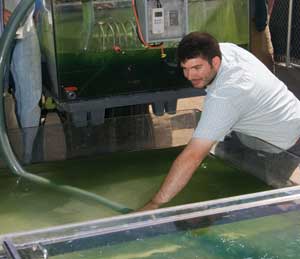March 2007
 View Full Print Edition
View Full Print EditionBusiness Briefs
Columns
View From the Hill
By Bob Dinneen
The Way I See It
By Mike Bryan

Dealing with Risks in Ethanol Plant Development
By Randy Shefman and John Eustermann

Legal Perspective
By Todd Guerrero and Katherine Roek
Editor's Note
By Tom Bryan
NBB In Sight
By Myron Danzer with contributions from Brad Albin, Matt Schultes and Tim Sullivan
Featured

Risk & Reward
By Michael Shirek
Technological breakthroughs have led to big efficiency gains in the ethanol industry, but the perceived failure rate of novel processes is a financial risk few lenders are willing to accept without supplementary backing or enticing variables.

Pricey Plants Pressure Development
By Jerry W. Kram
Ethanol plant project development is an increasingly complicated process as the price of everything from concrete to heat exchangers has skyrocketed. That inflation is eating into builder profits, and it has some potential ethanol producers taking a hard look at their project's bottom line.

Keys to Successful Equity Drives
By Nicholas Zeman
Ethanol plant developers should be able to find ample equity for sound, well-managed projects. Nevertheless, the structures upon which to build equity are still being tweaked.
A Return to Rationalism?
By Ron Kotrba
The investment surge that infiltrated the ethanol industry 18 months ago brought with it an expanded repertoire of chic finance options. As the smoke from that intense period clears, however, it's evident that Midwest farm banks didn't forfeit their power position in U.S. ethanol plant finance.

Pressure Point
By Craig A. Johnson
Will the rising demand for corn drive prices high enough to limit ethanol production? Will crude oil remain in the $50 to $60 per barrel range—or will it go even lower? Will ethanol prices inevitably dip to historical lows as the industry build-out continues? The answers to these critical questions are expected to shape the U.S. ethanol industry's near-term growth.
A World of Opportunity
By Bryan Sims
U.S. ethanol companies clearly have their work cut out for them in the United States. That's not keeping some from setting their sights abroad. EPM talks to some ethanol industry experts about what it takes to expand into foreign countries.

Navigating the Permitting Obstacle Course
By Anduin Kirkbride McElroy
Obtaining the permits necessary to build an ethanol plant may require the equivalent of jumping through hoops, climbing over walls and walking balance beams. For developers, sufficient preparation and the right "trainer" can mean the difference between a run-around and a run-through.
Leeway Through Legislation
By Lindsey Irwin
There's a new Congress in town and power has shifted from the Republicans to the Democrats. Although no bills have passed yet, it seems ethanol will continue to enjoy lavish attention from both sides of the political aisle and the White House.

The Urbane Powertrain
By Ron Kotrba
The Volvo Group is preparing for its commercial production launch of diesel-electric hybrid technology for heavy-duty applications-a launch the U.S. Air Force helped fuel.

The Poly-Refinery Plan
By Nicholas Zeman
The Ohio Soybean Council and the Battelle Memorial Institute are working together in the Buckeye State's capital city to pioneer new uses for soybean oil and glycerin. Researchers tell Biodiesel Magazine that polyol demand, and the ability of the compound to produce coatings, polymers and other materials provides a vast value-added stream for the biodiesel by-product.

Heeding Hydrogenation
By Susanne Retka Schill
Neste Oil aims to become to biodiesel what Nokia is to mobile phones. The Finnish firm has developed a proprietary process that produces a premium diesel from animal fats or vegetable oils. Just what is NExBTL, and who is Neste Oil?

Railroad Switch
By Anduin Kirkbride McElroy
Railroad companies have been slow to embrace biodiesel as a fuel for locomotives. Once the U.S. EPA's low-sulfur diesel ruling takes hold in June, however, the industry may be more apt to make the switch.

Growing Green, Growing Hope
By Lindsey Irwin
Similar to the growth pattern of the plant itself, interest in developing jatropha as a feedstock for biodiesel production is growing like a weed. The contracts that have been penned between companies like U.K.-based D1 Oils PLC and farmers in India and Africa are stimulating agricultural communities in some of the poorest nations in the world.

Algae on the Edge
By Jerry W. Kram
The National Renewable Energy Laboratory's Aquatic Species Program identified about 300 species of algae that have the potential to produce thousands of gallons of biodiesel per acre. Researchers and entrepreneurs are on the cusp of bringing this promising technology to commercial production.
Contributions
Survey Says: U.S. Drivers Want More Ethanol
By Amy George and Mike Bounama
Railroad Spill Containment Systems
By Rob Greenside
2006 Review and 2007 Outlook: Equity and Debt Capital Markets Activity
By Thomas Halverson, Christopher Flannery and Eric Pe






